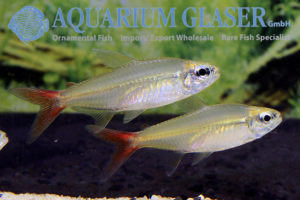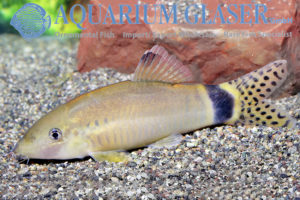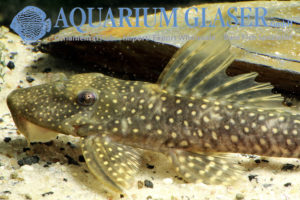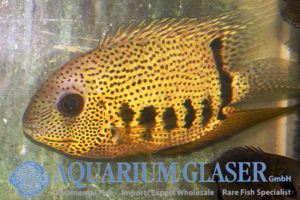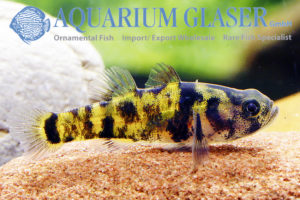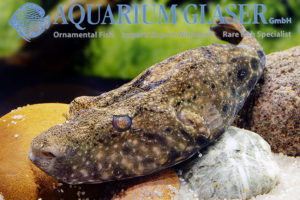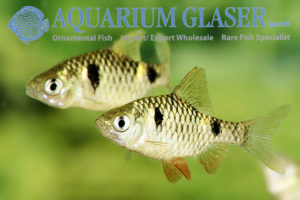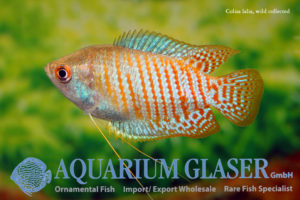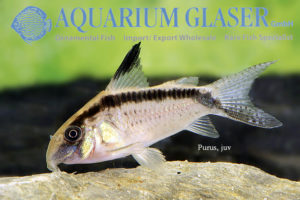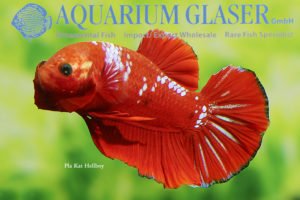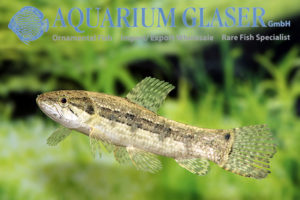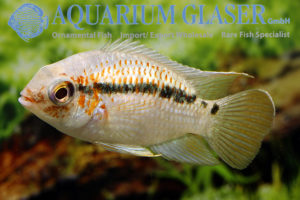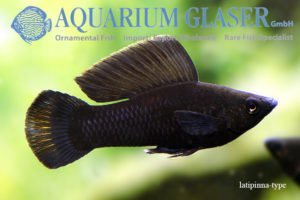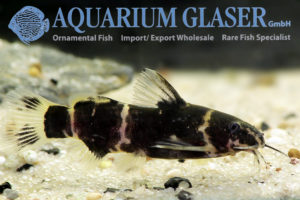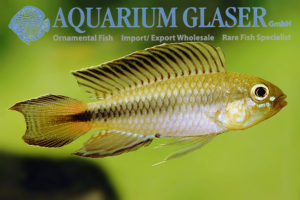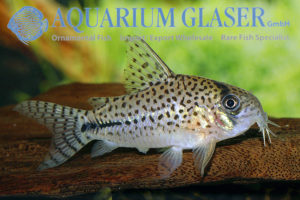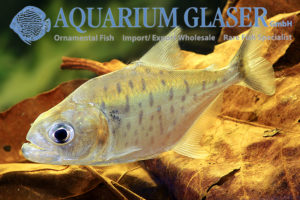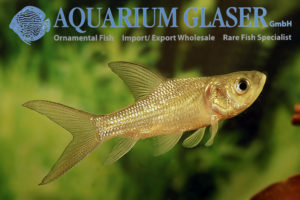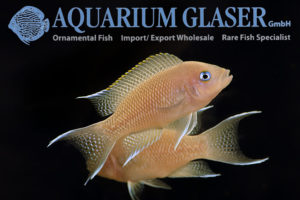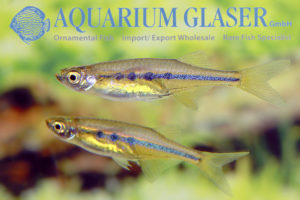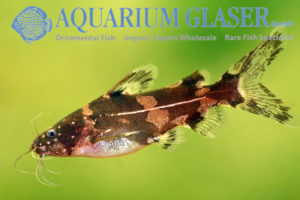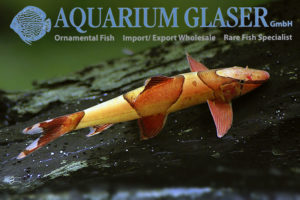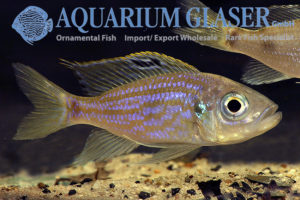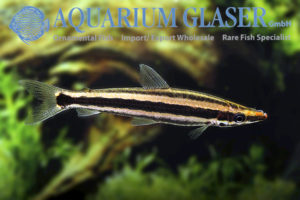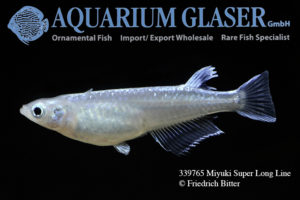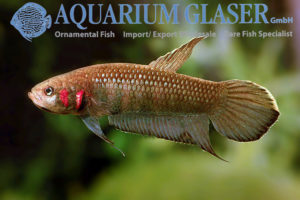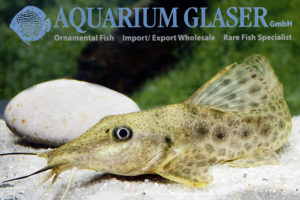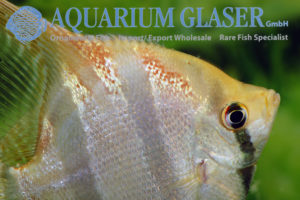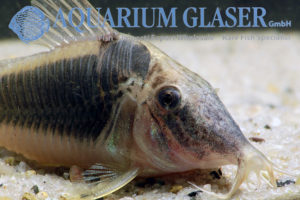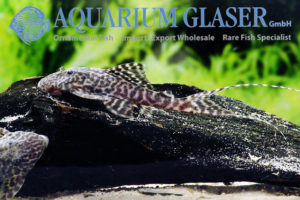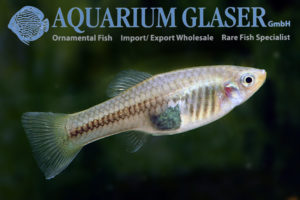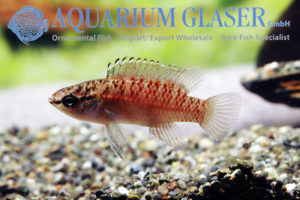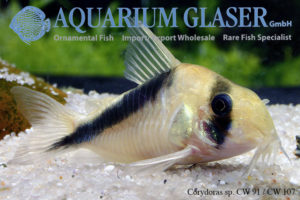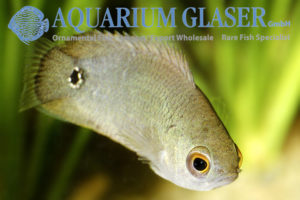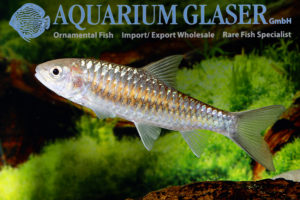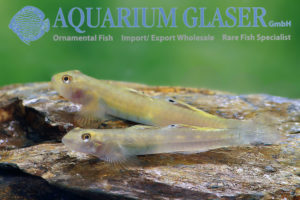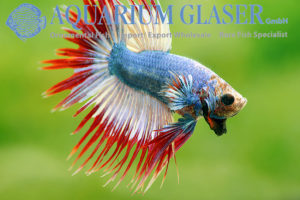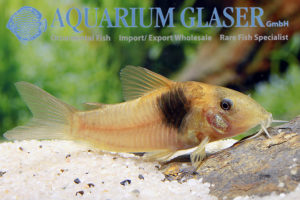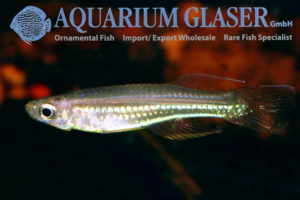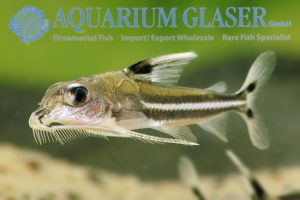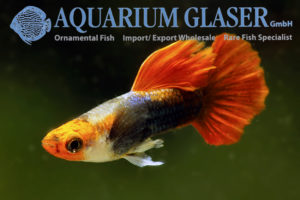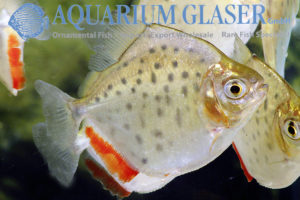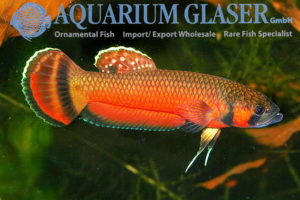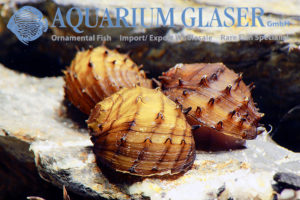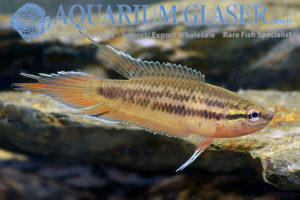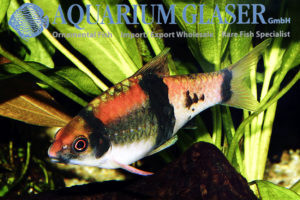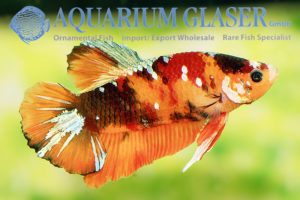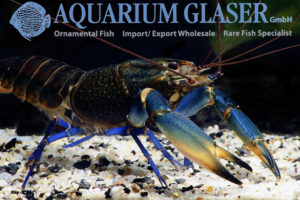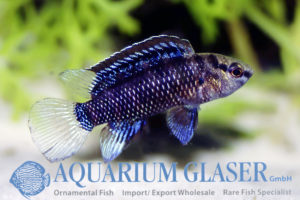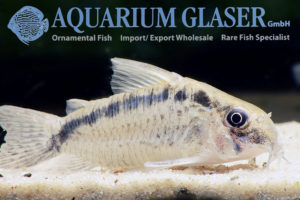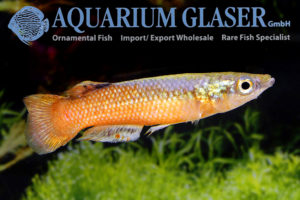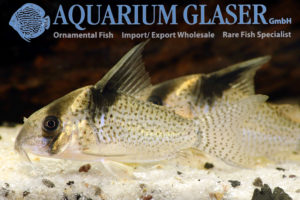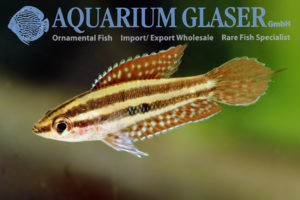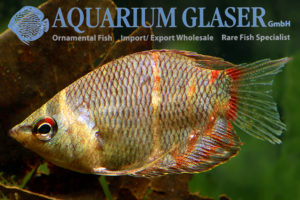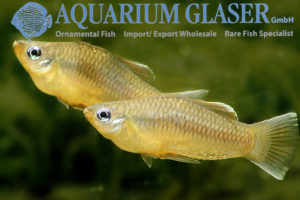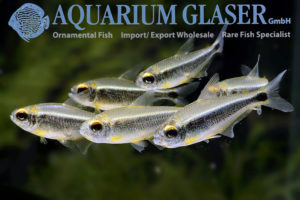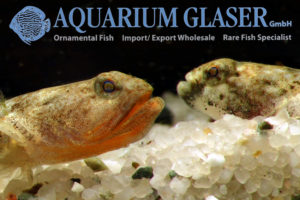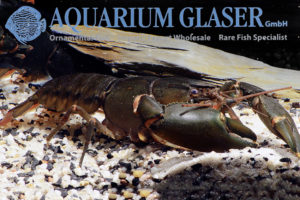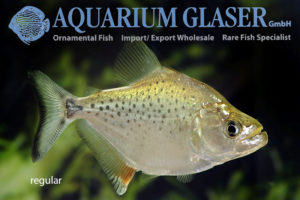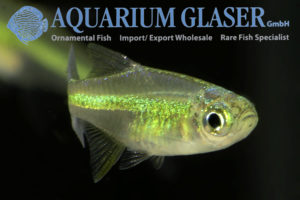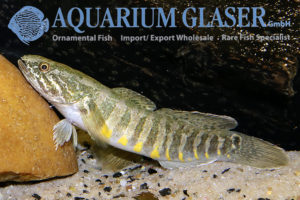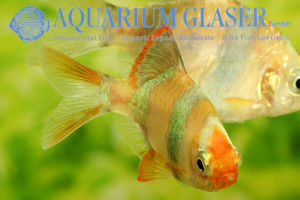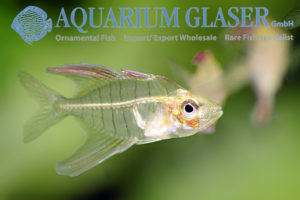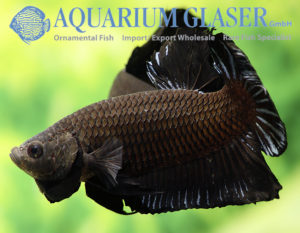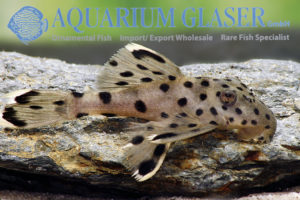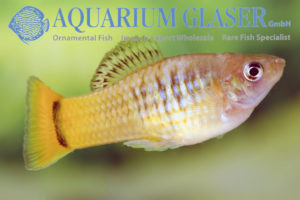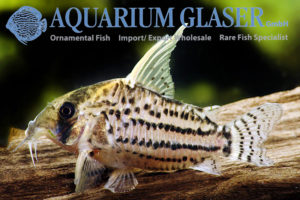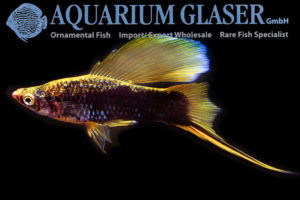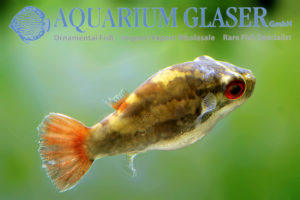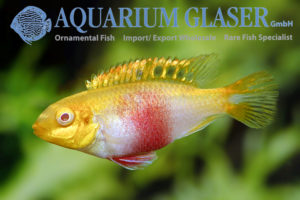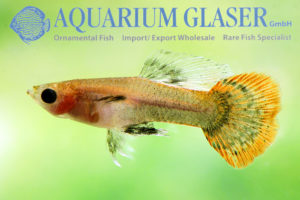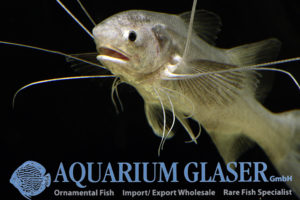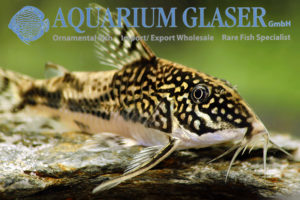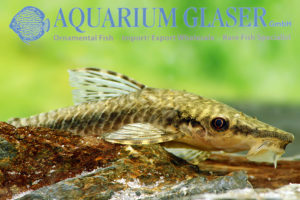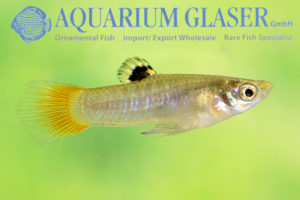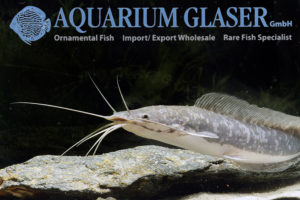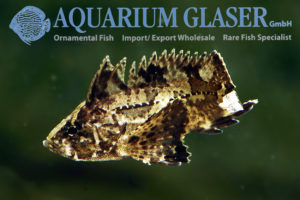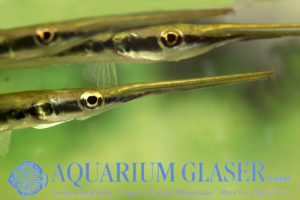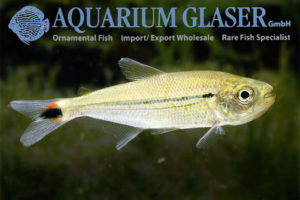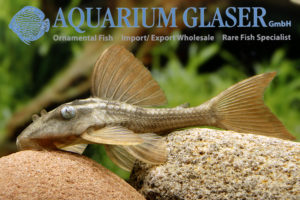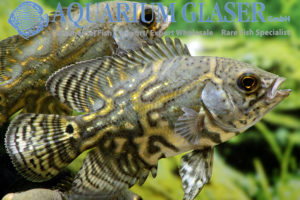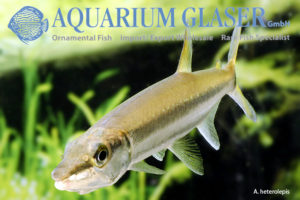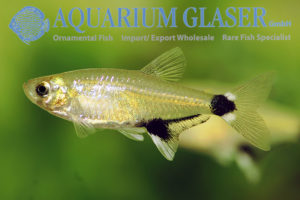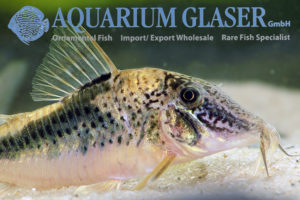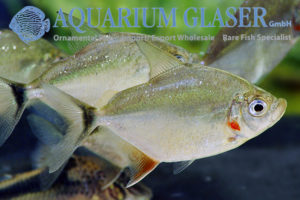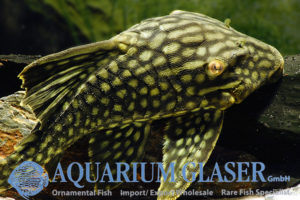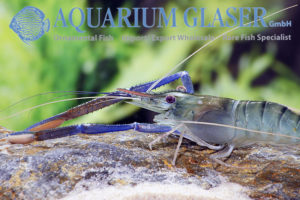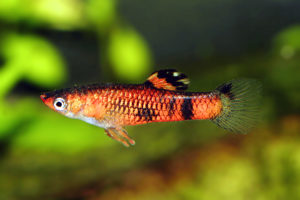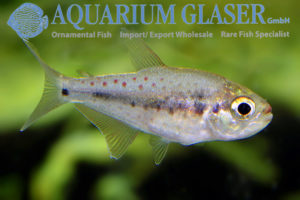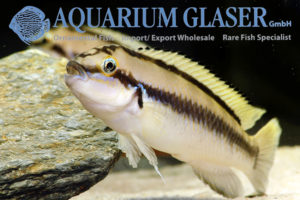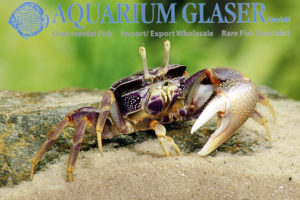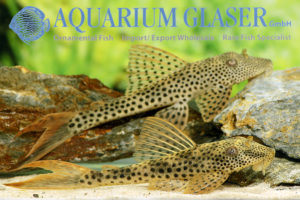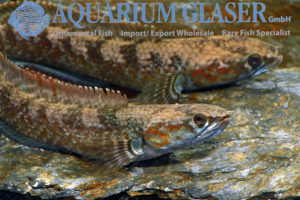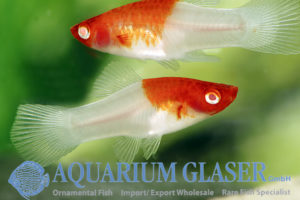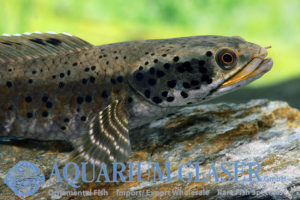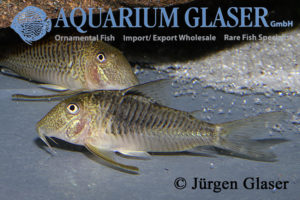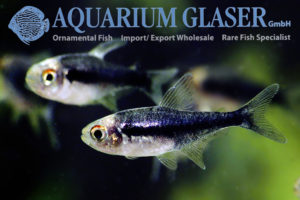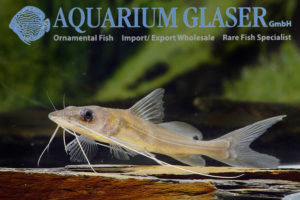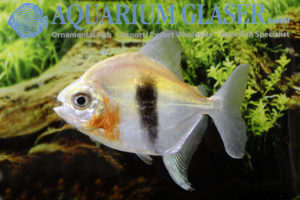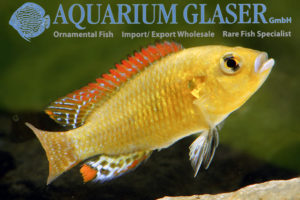From Venezuela we received a very nice color variation of Moenkhausia copei. The fish now look a bit like a stretched version of Moenkhausia collettii, where the shoulder spot so typical for M. collettii is missing and where the orange tail fin of M. collettii is red. We were able to import Moenkhausia copei for […]
Fish Archive (2968)
-
-
Yasuhikotakia splendida
The genus Yasuhikotakia was separated from the genus Botia by Teodor Nalbant in 2002 and currently comprises 10 species. Some of them are important aquarium fish like Y. morleti (older synonym: Botia horae) and Y. modesta. The newest species on the ornamental fish market is Y. splendida, which was described as Botia splendida in 1995. […]
-
Pseudancistrus sidereus
Nasty people could say: another brightly spotted brown-black loricariid catfish. But the heart of real fans of this group of animals beats faster at the sight of the fish, which differs from all other L-catfish by the combination of the crescent-shaped dorsal fin and the tail fin coloration, which is actually typical for Lasiancistrus species. […]
-
Heros notatus BRAZIL WILD
We have received wonderful Heros notatus from Brazil. A typical feature of this species are the dark spots in the lower half of the body. As with all Heros the sexes differ by the head colouring, however, it is not always easy to distinguish a strongly coloured female from a male standing far below in […]
-
Brachygobius sp. Ocelot
Again we could import this new species of dwarf bumble-bee goby. This tiny fish becomes only 2 cm long. It cannot be applied to any described species so far. The fish have been collected in Indonesia. In Brachygobius, one very important feature for determination is the question wether the predorsal region is scaled or naked. […]
-
Pao suvattii (= Tetraodon suvattii)
This freshwater pufferfish originates from the rivers of Thailand. Here it imitates stones and lurks for clueless feeder fish. In the aquarium it can be easily fed by large pieces of frozen food given by a forceps. The fish becomes around 12-15 cm long and looks very much alike the African cousin Tetraodon miurus. However, […]
-
Pethia phutunio (= Barbus p.)
The dwarf barb has delighted aquarium enthusiasts since it was first imported from India in 1906. This is not so much due to its magnificent colouring; dwarf barbs are pretty, but no colour miracles. Rather, the tiny animal, which only grows to 2-3 cm in size in nature, fitted wonderfully into the formerly common, relatively […]
-
Colisa lalia
The dwarf gourami is the perfect ornamental fish. It unites magnificent coloration, a peaceful mind and an interesting behaviour. It becomes only 3 cm (wild caughts) or 6 cm (artifical bred sports) long and due to its calm habit it can be kept even in smaller tanks. And if it comes to feeding: the dwarf […]
-
Corydoras arcuatus “Purus”
The skunk cory is one of the most famous Corydoras species – you might think! In reality it is most probably a scientifically undescribed species, while Corydoras arcuatus – this scientific name is used for the skunk cory – is hardly ever on the market. But regardless of that: the regularly in large numbers available […]
-
Betta splendens “Pla Kat Hellboy” and “Giant Halfmoon”
Again our proven supplier from Thailand sent us some special Betta delicatessen. The Pla Kat Hellboy is a velvet red, short-finned fighting fish, very often with blue scales (there are also plain red ones). The very special thing about it: the also deep red colored pectoral fins. The Giant Halfmoon are real giants and have […]
-
Hoplias malabaricus German bred
For the first time we can offer this predatory tetra as German bred ones! Hoplias malabaricus is one of the most widespread species of tetra in South America; it is therefore suspected that it is more likely to be a number of externally very similar, so-called cryptic species. The offspring was bred with a pair […]
-
Krobia xinguensis
This pretty cichlid has been described scientifically only in 2012. Up to that time it was known among hobbyists under the name of Krobia sp. “Xingu Red Head”. This nice relative of Aequidens is the ideal cichlid species for beginners, because it is one of the most peaceful species of cichlid at all. Besides this […]
-
Black Molly = Black Molly?
Sometimes we also take a closer look at the everyday species; one tends to judge fish like the Black Molly in trade only according to the aspects: 1. are the fish healthy and stable? and 2. are they well grown? But Black Molly is certainly not the same as Black Molly. Depending on which wild […]
-
Microsynodontis batesii
Squeakers or upside-down catfishes are a fish family occurring exclusively in Africa. The best known genus is Synodontis, which comprises over 130 species. Closely related to this genus is the genus Microsynodontis. The genus name means “small Synodontis” and is program, because these fish already become sexually mature with 3-4 cm of length, are thus […]
-
Apistogramma uaupesi
Apistogramma uaupesi is certainly one of the most beautiful dwarf cichlids. Adult males can be very variable colored, therefore A. uaupesi got several German popular names, like “Rotkeil-Apistogramma” or “Blutkehl-Apistogramma” (= Red Wedge and Blood Throat). In nature, however, all color variants occur together, so it is not a matter of locality forms, but of […]
-
Corydoras sp. C91
We received beautiful Corydoras sp. C91 from Peru (Rio Huallaga). The splendid species belongs to the closer relationship of Corydoras julii, C. punctatus, and C. trilineatus. The species was called Corydoras sp. “Heiko” or C. sp. “Peru-Bondi” in the trade before it was given a C-number. The peaceful schooling species gets the most brillant colours […]
-
Serrasalmus manueli
This piranha, described from Venezuela, is easily recognizable by its characteristic pattern in connection with the head profile, but still causes great confusion, as the fish in the trade come from completely different areas and are still indistinguishable. S. manueli was described as Pygocentrus manueli from the Río Paraguaza, middle Orinoco, Venezuela. The first description […]
-
Catlocarpio siamensis
The Giant Carp (Catlocarpio siamensis) is the biggest carp of Southeast-Asia with allegedly up to 3 m of length. However, such large animals have never been scientifically confirmed. The largest documented specimen was “only” about 150 cm long. In nature the Mekong giant carp is probably extinct or at least very, very rare. Fortunately, the […]
-
Neolamprologus marunguensis
Currently we can once again offer the little blue-eyed sister of the Princess of Burundi: Neolamprologus marunguensis. The beautiful dwarf cichlid from Lake Tanganyika belongs to the problem-free ornamental fish. As with all princesses, one can frequently observe multiple broods, with what the older siblings take part in keeping of the small young animals. Therefore, […]
-
Chela dadiburjori (= Laubuca dadiburjori, = Neochela dadiburjori)
This nano gem reached us from the south of India; the charming dwarf fish reaches a maximum size of 3 cm. It is an absolutely peaceful schooling fish that spawns on the upper side of broader leaves of submersed plants – Ludwigia-species are preferred. On our stocklist this species was intially written as dadyburjori; so […]
-
Pseudomystus funebris
Again we could import a cute blackwater dwarf catfish from Indonesia, this time from Borneo. Pseudomystus funebris was only scientifically described in 2010 and is extremely similar to P. heokhuii which occurs on Sumatra. Like the latter, it reaches a total length of about 6 cm. The species is very peaceful and also constantly on […]
-
Homaloptera parclitella
Hillstream loaches belong to the family of loaches. Probably the most beautiful species can be found in the genus Homaloptera. There are several closely related and similar looking species. In the German one calls it often “saddle-stain-loaches”, English, the animals become “lizard loaches” called. Homaloptera parclitella is an extraordinarily beautiful hillstream loach from the black […]
-
Aulonocranus dewindti
This interesting cichlid, the genus is monotypic with Aulonocanus dewindti, so currently only this one species is assigned to it, originates from Lake Tanganyika. The up to 14 cm long species is a mouth-breeder in the female sex and lives in the lake over sandy areas. Here the males dig pits in the sand, that […]
-
Anostomus ternetzi
The golden striped headstander, Anostomus tenetzi, has a very wide distribution in South America. It is recorded from Brazil, French Guyana, Guyana, Suriname, and Venezuela. The specimens on which the original descritption based, originated from Venezuela, and we were able to import them from there once more. This beautiful fish is among the most peaceful […]
-
Oryzias latipes – Medaka breeding forms
The care and breeding of the Japanese Rice Fish or Medaka has a very long tradition in Japan. Already around 1900 gold-colored Medakas were mentioned in the aquaristic literature. The breeding of these small fish is currently experiencing a renaissance in Japan. Friedrich Bitter drew attention to this and also imported many of these forms […]
-
Betta foerschi bred
The fighting fish of the Betta foerschi relationship – there are several very similar species, which are considered by some specialists to be only local varieties of the same species, namely Betta foerschi – are not only particularly beautiful, but also particularly interesting. They are mouth breeders, but they are, so to speak, at an […]
-
Auchenoglanis sp. Niger (A. biscutatus)
Until recently only two species of Auchenoglanis were recognized as vaild: A. biscutatus from the Nile and the whole of West Africa and A. occidentalis from Central Africa. But in 2010 the genus was revised by Retzer, who accepted a total of 8 different species, 7 already described formerly and one new species, namely A. […]
-
Pterophyllum „Santa Isabel“
We can offer just wonderful, young adult German bred offspring of the famous Santa-Isabel-Angel, which differs clearly from other wild collected angels by its attractive red coloration at the front-back. The animals are descendants of fish that we were able to import as wild catches some years ago (see: https://www.aquariumglaser.de/en/fish-archives/fantastic_pterophyllum_scalare_santa_isabel_arrived__en/). Especially worth mentioning is – […]
-
Corydoras Rarities
From Peru we received samples of some top rarities among the armored catfish. All belong to the group of long snouts, which in contrast to the round snouts do not live in swarms, but have to be laboriously collected individually. The species, called by the exporter as Corydoras sp. as “Melita”, belongs to the immediate […]
-
Panaqolus sp. L351
From Peru comes a Panaqolus, that is charcterized particularly through the small eye and the long tail fin filaments. With L351 they got their own code number. Unfortunately L351 is imported only very rarely, because most photos of this species show a darkly colored, unattractive fish. In reality, the animal is very nicely colored after […]
-
Xiphophorus andersi
Once again we can present and offer you a top rarity among the wild forms of livebearers: Xiphophorus andersi. Most likely the animals we have received from a German breeder are the first ever to be offered in the ornamental fish wholesale trade. Xiphophorus andersi comes from the Rio Atoyak in the state of Veracruz, […]
-
Dario kajal
The first reports of a new dwarf badis appeared in June 2004. Nonn Panitvong, an enthusiastic Thai aquarist, had found the animals in Bangladesh. Panitvong did not announce a more precise location, but said he caught the animals in a pond near a rice field, together with Danio rerio, Oryzias sp., Channa sp., Colisa chuna […]
-
Corydoras CW 89 / CW 91 / CW 106 / CW 107
From the Rio Vaupes in Colombia we have received a few specimens of two Corydoras species. These are real rarities. Corydoras sp. CW 107 reminds of Corydoras davidsandsi and we think it is the same species as Corydoras sp. CW 91. The long snouted counterpart of Corydoras sp. CW 107 is Corydoras sp. CW 106, […]
-
Ctenopoma breviventrale
Why should one keep grey fish? Some may ask themselves this question when looking at the pictures of this bushfish from the Congo. The answer is: the urge to explore! Unfortunately, many animal and plant species die out every day. Also many freshwater fish are strongly threatened by environmental changes – other factors such as […]
-
Neolissochilus stracheyi – Blue Tor
Once more we have this splendid large barb (maximum size: approx. 60 cm) from Burma in stock. We have only a limited number of specimens! If one photographs these fishes and sets the flashlight directly from the front the fish looks rather drab silvery. But in the real life, when the fish is swimming, the […]
-
Lentipes ikeae
The goby subfamily Sicydiinae currently comprises nine genera with 129 species. They are all current-loving animals, which occur in nature mainly in clear streams and feed on Aufwuchs and small animals. Larval development takes place in the sea. Some neon gobies of the genus Stiphodon are particularly popular, while representatives of other genera are very […]
-
Betta splendens “Crown Tail Thai Flag”
Three-coloured fighting fish have been around for many decades, they are usually called “Butterfly Bettas”. At the moment we have some specimens of a not only beautiful, but also symbolic Betta breed in stock, which are dyed in the national colours of Thailand! According to Wikipedia, the current flag of Thailand, a tricolour with five […]
-
Corydoras sp. CW 16 “teniente”
Recently we received a shipment of highly interesting fish from the entry of Madre de Dios in the border area between Peru and Bolivia. Among them were beautiful corydoras catfish from the closer relationship of Corydoras melanotaenia. However, it is certainly a scientifically undescribed species, which was documented by Ian Fuller with the code number […]
-
Aplocheilichthys luxophthalmus (= Poropanchax luxophthalmus)
Currently we were able to import once more one of the most beautiful lampeyes from Nigeria: Aplocheilichthys luxophthalmus. Those who follow the splitting of the genus Aplocheilichthys place the maximum 3 cm long fish in the genus Poropanchax. A. luxophthalmus is a schooling fish that should never be kept in groups with less than ten […]
-
Tenellus trimaculatus
From Peru we have received this nice catfish, which can be recognized by its species-typical pattern: A black spot at the base of the dorsal fin, two at the middle base of the caudal fin. The species name also refers to this (trimaculatus = with three spots). The peaceful animal becomes about 10 cm long. […]
-
New highly selected guppys: Koi Red Tuxedo Red Nose and Full Black
In this case “new” does not mean that there were no colour varieties like this before, but that we have a new breeder, who gives us these and other high end breeding guppies in pairs and colour hits, so that we can pass on really fantastic animals. Of course there is also a certain variance […]
-
Metynnis maculatus
There are two rather similar species of the silver dollar genus Metynnis with a pattern of black spots. They differ mainly by the (externally not visible) number of the gill rakes and the number of scales along the long side of the body, but also somewhat in relation to the body shape. We currently call […]
-
Betta macrostoma
For sure Betta macrostoma is one of the most beautiful species of fighting fish – and the most sensitive! There is hardly another known species of fish that becomes that easily infested by bacteria of any kind. Many breeders of Betta macrostoma use UV filters the whole year through to avoid bacterial development in the […]
-
Neritina juttingae
The Neritina snails are enjoying growing popularity among aquarists. There are several reasons for this. The most important one is certainly that they look attractive. In addition, Neritina snails do not reproduce in freshwater aquariums, as the larvae only develop in the sea. The third important reason for the popularity is that Neritina snails also […]
-
Pseudosphromenus dayi
The red spike-tail is a classic among the aquarium fish and is and is not missing in any manual of ornamental fish science before the Second World War. But its origin was always mysterious, the original description from the year 1909 was based on aquarium imports. Today it has become quiet around him and his […]
-
Haludaria fasciata, the melon barb (formerly: Barbus fasciatus)
In the south of India rises the ancient high plateau of the Deccan, which was already formed when India was still part of Africa. From here numerous small rivers flow directly into the Indian Ocean and in many of these rivers own colour variations, subspecies or species of freshwater fish have formed due to the […]
-
Betta splendens „Emerald Candy“
This is the latest Betta creation from Southeast Asian breeders. A multicoloured short fin, where matte scales and emerald green shining body and fin parts contrast wonderfully with each other. For the first time we have received a hand-picked selection of this new breed from Betta splendens „Emerald Candy“. For our customers: the fish have […]
-
Cherax sp. Blue Moon Black Body / Black Scorpion Blue Leg
The variety of colours of the crayfish on New Guinea is really amazing. In the trade it is often problematic to assign the import animals exactly to any species, because the colouring is also very variable within the species and only rarely all specimens of an import look the same. Be that as it may: […]
-
Badis badis
The blue perch is a classic among aquarium fish and has been in the hobby for over 100 years. The maximum length of the peaceful animal is 5 cm. Males in courtship display are almost black with sometimes blue shimmering fins, in neutral colouring the animals are reddish brown with vertical black bandages (which can […]
-
Corydoras cf. urucu
Once again we were able to import a new catfish, whose identity raises many questions. The fish were offered to us as Corydoras evelynae, a species that was described by only one specimen with a very inaccurate location (“upper Solimoes”, which includes an area larger than Germany). Our new imports were collected in the surroundings […]
-
Pachypanchax sakaramyi – one of the rarest fish in the world
Although the species Pachypanchax sakaramyi – it originates from the Sakaramy River on Madagascar – was described as early as 1928, it could not be found for decades afterwards and even was referred to the realm of legends. It was not until the 1990s that they were found again. From these animals (5 pairs), which […]
-
Corydoras sp CW 98
This beautiful Corydoras belongs to a scientifically undescribed species. It originates from the upper Rio Negro in Brazil. Because of the bright orange neck spot it is usually misidentified as Corydoras burgessi, which also comes from this region, especially as C. burgessi has a very variable pattern and there are also spotted colour variants of […]
-
Parosphromenus linkei
The magnificent licorice guramis (Parosphromenus) have experienced a species explosion in recent years. Until 1979 only three species were known, today there are 20 scientifically described species and some more undescribed ones are already known in the hobby. Unfortunately, many are threatened with extinction because they live in peat swamps and these habitats are drained […]
-
Sphaerichthys osphromenoides
From Indonesia we received beautiful, very large and strong chocolate Guramis (Sphaerichthys osphromenoides). Unfortunately the exact place of origin is not known, but we suspect that they come from the Indonesian part of Central Borneo, Kalimantan. Particularly noticeable in the animals is their high red portion in the coloration, which is however somewhat different with […]
-
Priapella compressa
The Blue-eyes from Mexico are closely related to the Knife-bellies (Alfaro). Like these, the males of Priapella have a massive keel along the underside of the tail. All Priapella attract attention by their blue, shining eyes. They are powerful swimmers who appreciate a good current. In nature they live close to the surface in clear […]
-
Moenkhausia heikoi
For the first time we could import, even if only in very limited numbers, this tetra from the Rio Xingu described only in 2004. The animal became known in 2001, when Rainer Stawikowski presented the fish as “Hemigrammus sp. Xingu” in the journal DATZ. The scientific description took place in 2004, twice and almost simultaneously: […]
-
Schismatogobius risdawatiae
The dragonet gobies (Schismatogobius) are small species of freshwater gobies, that reach between 3 and 5 cm length. They live in small rivulets near the coast but above the tide on sandy bottoms. Here they burry themselves very fast if necessary. The larvae devolop – as far as this known – in the sea. The […]
-
Cherax sp. „Black Scorpion“
Along with other species of Cherax,, which we have already introduced to you, we have received the Cherax sp. “Black Scorpion”. They are very attractive animals whose care and breeding does not differ significantly from that of the previously known Cherax forms from New Guinea. For our customers: The animals have code 481473 on our […]
-
Serrasalmus compressus – a very interesting piranha from Peru
Recently we obtained a shipment of piranhas from Peru. The fish are 5-9 cm long. At the first glimpse the shipment could be told apart into two phenotypes. First, there were fish with comparatively small spots, a lot of red coloration in the anal fin and a comparatively thin black border on the caudal fin. […]
-
Microdevario kubotai
Microdevario kubotai This extraordinary beauty is a real dwarf (maximum length around 2.5 cm). It originates from the southwestern province of Ranong in Thailand (which forms a border to Burma) and is now available in perfect quality. Initially this fish has been described in the genus Microrasbora, but has been transferred together with M. gatesi […]
-
Bostrychus zonatus
Bostrychus zonatus is a sleeper goby and becomes about 15 cm long. They are predatory fish, which should therefore only be kept together with species that have at least half the body length of the gobies, larger is safer. The beautiful animal is widespread in fresh and brackish water in New Guinea and northern Australia. […]
-
Puntigrus anchisporus (= Barbus tetrazona) Gold Green Stripe
About 10 years ago the breeders suddenly focussed again on the old-known tiger barb, whose scientific name is, by the way, Puntigrus anchisporus. Puntigrus tetrazona is a species that is practically never seen in the aquarium, the edges of its fins, which are coloured red in the tiger barb, are black. One of the new […]
-
Gymnochanda ploegi
For the first time we received this dwarf glass perch from Indonesia, which was named in honour of Alex Ploeg, who was in the passenger plane shot over Ukraine on 17 July 2014. G. ploegi is known so far only from West Kalimantan, the part of Borneo belonging to Indonesia. It is a pure freshwater […]
-
Betta splendens Black Knight Pla Kat
Black knights – that’s what Thai breeders call this beautiful, short-finned fighting fish, which we can offer at the moment. The animals are colored so intensively black that you can’t see any detail on normal exposed photos, they just look like a black surface. But if you overexpose strongly, you can see that the black […]
-
L264 Leporacanthicus joselimai German bred
Leporacanthicus joselimai (L264) comes from the Rio Tapajós in Brazil and grows 15-20 cm long. It belongs to the carnivorous species of suckermouth catfish and should therefore be fed with a wide range of feed, such as frozen food, granules, flakes, etc.. Since most of the food is eaten at night, it is necessary to […]
-
Xiphophorus variatus “Puente Escalanar”
Once again we can offer a extremely beautiful wild strain of the variatus platy in good numbers as German offspring. The ancestors of these animals were collected in 2002 in Puente Escalanar, Veracruz, Mexico by private hobbyists and brought along. Since then, the animals have enthused mainly the community of friends of livebearers; to our […]
-
Corydoras sp. „Super Schwartzi Highfin“ CW 28
Corydoras schwartzi is one of the most frequently offered armored catfish from Brazil. It comes from the basin of the Rio Purus. There are other very similar species, such as the magnificent, long-snouted C. pulcher. The short-snouted sister species of C. pulcher is also available from there; we call it Corydoras cf. pulcher; there are […]
-
Xiphophorus hellerii „Hamburg Highfin“
Only very rarely one of the most beautiful breeding forms of the swordtail comes to us: the black Simpson with orange fins. Among fish lovers Bayreuth is known as the spade for this very distinctive swordtail breeding form and is called “Bayreuth Cross”. In Germany, this variant was first exhibited in 1968 (report by the […]
-
Carinotetraodon irrubesco
Pufferfish are most often thought to be brackish water fishes. But there do exist indeed species that are adopted to totally fresh water. Some of them even live in the very soft and acidic waters of the forests. Among the latter are the species of Carinotetraodon from Indonesia; we currently could import once more C. […]
-
Pelvicachromis pulcher Albino
Breeding forms are like certain foods: you like them – or not. But it is a fact that the aquarium hobby, like all other areas of domestic animal and plant care, cannot get along without breeding forms. The albino of the krib, Pelvicachromis pulcher, is a breeding form whose charm is not obvious at […]
-
Guppy “Red Smoke”
Glasbelly guppies do not produce guanine due to a genetic peculiarity – this is the silver dye that makes fish glisten. This makes them more or less transparent, as the guanine normally reflects the light and prevents transparency like a mirror. Mostly Glasbelly guppies are bred as albinos. If the black melanin also falls away, […]
-
Polynemus paradiseus
Currently we have a really unusual species of fish in our fishhouse: Polynemus paradiseus. The Polynemidae family is almost unknown to hobbyists, despite the fact that over the centuries 96 species have been described, 42 are still valid, and these fish are important food fishes in their home range. Two species of the genus Polynemus […]
-
Scleromystax barbatus
No doubt: this cory from the south of Brazil, where it inhabits cool blackwater brooks near the coast, is among the most beautiful species of cory at all. Sadly it is not exported from Brazil currently. Keeping this fish is usually problem-free, but breeding is due to the high demands (cool, very clean water with […]
-
Hypoptopoma gulare
The genus Hypoptopoma comprises small to medium sized loricariids. The largest species known becomes about 10 cm long. At the first glimpse they look much alike a Otocinclus, but larger. Typical for members of Hypoptopoma is the position of the eyes. They are placed in way at the side of the head that the fish […]
-
Poecilia caucana
With an overall length of 3 – 5 cm the Cauca Molly (Poecilia caucana), originating from Colombia, Venezuela, and Panama belongs to the smaller livebearers. Remarkably is the yellow – orange coloured dorsal fin and a violet metallically shining along the body as well as the orange band in the proximal part of the caudal […]
-
Clarias gariepinus
The airbreathing catfishes of the genus Clarias are among the most important food fishes that are bred in aqua culture in the tropics. They are absolutely undemanding in respect of water quality and the fact that they readily accept any food as long as it contains enough protein makes them ideal candidates for aqua culture. […]
-
Neovespicula depressifrons
The order of scorpionfishes is as well famous as famed. Without scorpionfishes a real bouillabaisse is unthinkable, without lionfishes public aquaria and marine hobbyists would miss a wonderful attraction, but all members of this order have venomous spines and can inflict very painful – in case of the stonefishes even eventually deadly – stings. Scorpionfishes […]
-
Potamorrhaphis labiatus
The slender freshwater needlefish from South America are much sought for by specialists. Many years only one species was mentioned in the aquarium literature, namely Potamorrhaphis guianensis. This species really exists and is said to be fairly wide spread in South America. But it seems that the needlefish we obtain from Peru currently belong to […]
-
Jupiaba sp. „Cherry Spot“
We were able to import a new species of tetra from Venezuela which does not resemble to any species known to us. According to the collector the animals were collected in small brooks in the surroundings of Puerto Inirida. There are no doubts that our new imports belong to the Astyanax relationship in the broadest […]
-
L137 Hypostomus soniae / Cochliodon soniae
The pretty, blue-eyed L137 from the Rio Tapajós is only rarely offered. It is a medium-sized species of Hypostomus that can reach a maximum length of about 20 cm. The colour of the fish is quite variable. Specimens exist that have rather brown fins, others have spotted fins and again others have bright orange-red fins. […]
-
Astronotus ocellatus Colombia
We obtained very nice juveniles of the Oscar from Colombia. In contrast to the adults the juveniles are strictly schooling fish. In case of a real or imaginary danger the fish school performs a kind of globe. This behaviour also explains the otherwise illogical attractive pattern. In a school this pattern works as a camouflage, […]
-
Acestrorhynchus heterolepis and A. microlepis
For the first time we were able to import Acestrorhynchus heterolepis, which has been described scientifically as early as 1878 by Cope from Peru. Our specimens originate from Venezuela; it was a mixed shipment of these fish and A. microlepis*. A. heterolepis has two dark horizontal bands, thus reminding a bit in A. isalinae; however, […]
-
Aphyocharax paraguayenis
This small, about 4.5 cm maximum length reaching tetra belongs to the most attractive species of tetra at all. The species is very hardy and undemanding and can be easily bred in huge numbers. It is a fish of the subtropical regions and doesn´t even require a heater. In the wild, water temperatures between 16 […]
-
Corydoras fowleri Variant
Corydoras fowleri is a very rare and very beautiful species of Corydoras. The species originates from Peru. It is well known for its high degree of variability in respect of coloration. Our latest import contained specimens that looked very different from their conspecifics. They have a strong golden-bronze coloration of the neck and an overall […]
-
Catoprion mento
Photos: Frank Schäfer
-
Panaque sp L330
The „Full Spotted Royal Pleco“ belongs to the very attractive members of the wood-feeding genus Panaque. The species attains a maximum size of about 40 cm. Sadly in young fish the adult coloration cannot become even guessed, they are striped, like many other members of the genus. Only in halfgrown fish the spotted pattern has […]
-
Macrobrachium rosenbergii
The largest species of freshwater shrimp at all is Macrobrachium rosenbergii. Males of the species can reach a length of 50 cm (inclusive the long arms), as is shown by the specimens we photographed years ago on a food marked in Thailand. Despite that enormous size the species does not get old. Scientific research found […]
-
Micropoecilia picta Red
This extremely beautiful livebearer has been discovered in 1991 by Dieter Bork in eastern Venezuela near Tucupita. Here it inhabits the floodplains of the Orinoco river. Bork was able to collect and export some specimens. Micropoecilia picta is very variable in respect of coloration. However, in contrast to M. parae, usually only one colour variety […]
-
Pseudochalceus kyburzi
After many years we finally were able again to import this very beautiful tetra from Colombia once more. This species attains usually a length of about 5 cm, the largest one reported had about 8 cm in length. In respect of the general look and the behaviour Pseudochalceus kyburzi can be best compared with the […]
-
Telmatochromis vittatus
Only comparatively rarely Telmatochromis vittatus from Lake Tanganyika can be found in the trade, despite the fact that this dwarf cichlid – it becomes only about 8.5 cm long – is perfectly suited for keeping and breeding in home aquaria. Maybe this is due to the fact that the fish look somewhat similar but not […]
-
Uca tangeri
The eastern Atlantic from Portugal to Angola, is the origin of the fiddler crab Uca tangeri, where it inhabits sand and mangrove coasts. We obtain the animal from Nigeria. The to an enormous size grown major claw of the males is remarkable. It is used for attracting the females and for the fight between rivaling […]
-
Squaliforma cf. emarginata L11
Among the loricariid catfishes that are known by scientists for a very long time already is this species. It has been described initially 1840 under the name of Hypostomus emarginatus. Since then it has been placed in different genera, in 2001 in Squaliforma and in 2016 in Aphanotorulus, when Squaliforma has been considered to be […]
-
Channa sp. New Mimetic Orange Blotch
Along with the yellow-lipped variety of Channa ornatipinnis this undescribed dwarf snakehead was collected. Currently the fish are about 12-15 cm long and seem to be fully grown; however, this cannot be said without some questionmarks. The whole habit and the coloration of the fish reminds one strongly in Channa andrao from North Bengal, but […]
-
Xiphophorus hellerii „Kohaku“
Red-white, koicoloured livebeares are very hip currently. Usually the commercial breeders do not name their creations by their genetic compostion – like private hobbyists do -, but name them instead with as fancy names as possible. The „Kohaku“ is a white albino swordtail with a bright red patch on the front part of the body. […]
-
Channa ornatipinnis
When in 2007 the comparatibly small (about 20-25 cm) and very colourful species Channa ornatipinnis was described from the Rakhine State in Burma the fans of snakeheads were really enthusiastic. Soon after the first specimens appeared in the ornamental fish market. Since then the fish were offered regulary, but only from time to time. But: […]
-
Corydoras geoffroy
For a very long time this species of Corydoras – the type species of the entire genus! – was a myth. Until now it is a top-rarity among the corys. So we are extremely glad that our proofed breeder for special cases, Kurt Jülich, was successful in breeding with wild collected specimens. We can offer […]
-
Hyphessobrycon herbertaxelrodi „Smoke“
This is a very interesting and beautiful new sport of tetra. One can only guess that it belongs to the species Hyphessobrycon herbertaxelrodi, but there is no other species known in the hobby that fits better. Two characters make this fish very desirable: the extraordinary strong schooling behaviour and the intensive dark coloration of the […]
-
Sperata acicularis
The catfish of the genus Sperata can be easily identified due to the black spot in the adipose fin. Determination of the the four currently accepted species, on the other hand, is a tricky thing. Only S. seenghala, a widespread species from India, can be comparatively easily identified, because in that species the eye is […]
-
Myloplus schomburgkii “Big Black Stripe”
Obviously many different varieties – or do they even represent different species, who knows? – of the attractive pacu Myloplus (formerly: Myleus) schomburgkii exist. We obtained recently very nice specimens from Colombia, which are characterized by the very broad black band over the body. Our fish are 9-12 cm long and only subadults; Myloplus schomburgkii […]
-
Pseudocrenilabrus philander dispersus
When in 1902 the Dwarf Egyptian Mouthbrooder (Pseudocrenilabrus multicolor) was imported for the very first time hobbyists were really enthusiastic about it. The mouthbrooding behaviour which lasts in that species a good time longer than the first release from the maternal mouth was simply fascinating for our ancestors to observe. Some years later – 1911 […]
- « Previous Page
- 1
- …
- 9
- 10
- 11
- 12
- 13
- …
- 30
- Next Page »





